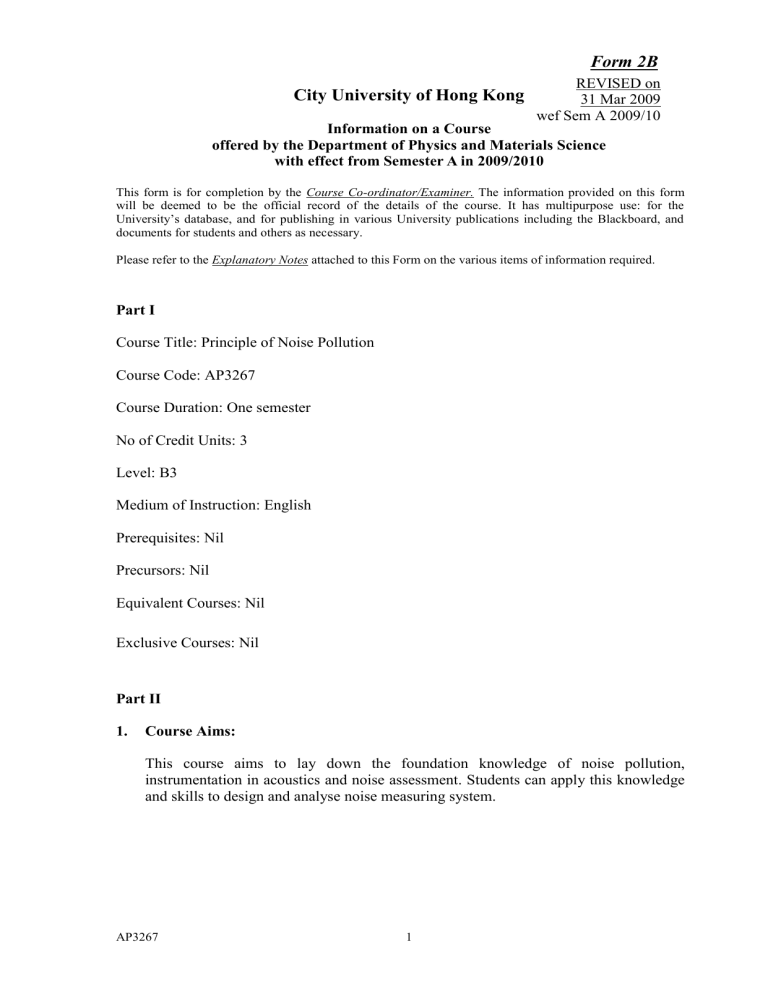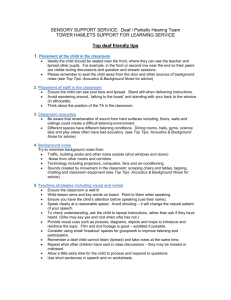Department of Physics and Materials Science

Form 2B
City University of Hong Kong
REVISED on
31 Mar 2009 wef Sem A 2009/10
Information on a Course offered by the Department of Physics and Materials Science with effect from Semester A in 2009/2010
This form is for completion by the Course Co-ordinator/Examiner.
The information provided on this form will be deemed to be the official record of the details of the course. It has multipurpose use: for the
University’s database, and for publishing in various University publications including the Blackboard, and documents for students and others as necessary.
Please refer to the Explanatory Notes attached to this Form on the various items of information required.
Part I
Course Title: Principle of Noise Pollution
Course Code: AP3267
Course Duration: One semester
No of Credit Units: 3
Level: B3
Medium of Instruction: English
Prerequisites: Nil
Precursors: Nil
Equivalent Courses: Nil
Exclusive Courses: Nil
Part II
1.
Course Aims:
This course aims to lay down the foundation knowledge of noise pollution, instrumentation in acoustics and noise assessment. Students can apply this knowledge and skills to design and analyse noise measuring system.
AP3267 1
2. Course Intended Learning Outcomes (CILOs)
(state what the student is expected to be able to do at the end of the course according to a given standard of performance)
Upon successful completion of this course, students should be able to:
No CILOs Level of
Importance
1 1 Recognize common-used parameters of noise pollution and decibel scale.
2 Familiar with the structure of human ear and identify the objective and subjective measures of sounds.
3 Familiar with sound instruments, principle and application.
4 Apply basic theories to solve simple problems in room acoustics and aircraft noise.
5 Apply appropriate technique and instrumentation for noise measurement.
2
3
2
2
3. Teaching and Learning Activities (TLAs)
(designed to facilitate students’ achievement of the CILOs)
TLAs
CILO 1
CILO 2
CILO 3
CILO 4
Large Class
Activities
4
4
8
8
2
Small Class
Activities
2
2
4
4
1
Laboratory
Work
--
--
--
3
--
Literature
4. Assessment Tasks/Activities
(designed to assess how well the students achieve the CILOs)
Study
--
--
--
--
--
Total no of hours
6
6
12
15
3 CILO 5
Total (hrs) 26 13 3 -- 42
Suggested lecture/tutorial/laboratory mix: 2 hrs lecture + 1 hrs tutorial or laboratory
Examination duration: 2 hrs
Percentage of coursework, examination, etc.: 30% by coursework; 70% by exam
To pass the course, students need to achieve at least 30% in the examination.
ATs Exam Assignments
CILO 1
CILO 2 10
CILO 3
10
20
2
2
Mid-term
Test
3
3
3
Lab
Report
--
--
--
Literature
Study Report
--
--
--
Total (%)
13
15
25
AP3267
CILO 4 20
CILO 5 10
Total
(%)
70
2
2
8
3
--
12
2
--
10
10
--
--
0
25
22
100
5. Grading of Student Achievement: Refer to Grading of Courses in the Academic
Regulations (Attachment) and to the Explanatory Notes.
The grading is assigned based on students’ performance in assessment tasks/activities.
Grade A
The student completes all assessment tasks/activities and the work demonstrates excellent understanding of the scientific principles and the working mechanisms. He/she can thoroughly identify and explain how the principles are applied to science and technology for solving physics and engineering problems. The student’s work shows strong evidence of original thinking, supported by a variety of properly documented information sources other than taught materials. He/she is able to communicate ideas effectively and persuasively via written texts and/or oral presentation.
Grade B
The student completes all assessment tasks/activities and can describe and explain the scientific principles. He/she provides a detailed evaluation of how the principles are applied to science and technology for solving physics and engineering problems. He/she demonstrates an ability to integrate taught concepts, analytical techniques and applications via clear oral and/or written communication.
Grade C
The student completes all assessment tasks/activities and can describe and explain some scientific principles. He/she provides simple but accurate evaluations of how the principles are applied to science and technology for solving physics and engineering problems. He/she can communicate ideas clearly in written texts and/or in oral presentations.
Grade D
The student completes all assessment tasks/activities but can only briefly describe some scientific principles. Only some of the analysis is appropriate to show how the principles are applied to science and technology for solving physics and engineering problems.
He/she can communicate simple ideas in writing and/or orally.
Grade F
The student fails to complete all assessment tasks/activities and/or cannot accurately describe and explain the scientific principles. He/she fails to identify and explain how the principles are applied to science and technology for solving physics and engineering problems objectively or systematically. He/she is weak in communicating ideas and/or the student’s work shows evidence of plagiarism.
Part III
Keyword Syllabus:
Introduction
Basic principles and definitions, sound pressure, sound intensity and sound power, the decibel scale.
The human ear
The structure of the ear, types of deafness, frequency response, subjective measures of sound, loudness, perceived noisiness, noise criteria and noise rating
AP3267 3
curves.
Measurement of sound
Instrumentation, sound level meters, spectrum analyzers, sound intensity meter, types of microphone, frequency weighting, time weighting, noise dose, statistical analysis of noise.
Acoustics
Wave equation for airborne sound, directivity, the near field, far field and reverberant field, room acoustics, absorption and reverberation time.
Environmental noise and their characteristics
Community noise, industrial noise, highway and other surface transportation noise, and aircraft noise.
Recommended Reading:
Anderson J S and Bratos-Anderson M, “Noise: Its Measurement, Analysis, Rating and
Control”, Avebury Technical (latest ed.).
Reference Book(s):
Irwin J D and Graf E R, “Industrial Noise and Vibration Control”, Prentice-Hall, New
Jersey (latest ed.).
Lipscomb D and Taylor A C, “Noise Control: Handbook of Principles and Practice”, Van
Nostand Reinhold (latest ed.).
Peterson A P G, “Handbook of Noise Measurement”, 9th Ed, Genrad Inc., (latest ed.).
Returned by:
Name: Dr T CHEUNG
Extension: 7813
Department: AP
Date: 31 Mar 2009
AP3267 4







